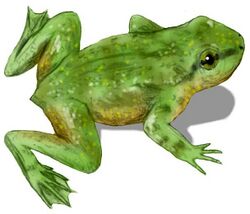Biology:Prosalirus
| Prosalirus | |
|---|---|

| |
| Prosalirus bitis | |
| Scientific classification | |
| Domain: | Eukaryota |
| Kingdom: | Animalia |
| Phylum: | Chordata |
| Class: | Amphibia |
| Order: | Anura |
| Family: | †Prosaliridae |
| Genus: | †Prosalirus Shubin & Jenkins, 1995 |
| Type species | |
| Prosalirus bitis Shubin & Jenkins, 1995
| |
Prosalirus is the name given to a fossilised prehistoric frog found in the Kayenta Formation of Arizona in 1981 by Farish Jenkins.[2] The type, and currently only, species is Prosalirus bitis.
Description
The skeleton has primitive features, but has mostly lost the salamander-like traits of its ancestors. It has a skeleton designed to absorb the force of jumping with its hind legs and tail. It also has long hip bones, long hind leg bones, and long ankle bones, all similar to modern frogs, and is as of 2009 the earliest true frog. [1]
The name comes from the Latin verb prosalire, meaning 'to leap forward'. It is thought to have lived during the Early Jurassic epoch 190 million years ago, well before the first known modern frog, Callobatrachus.[3]
As of 2020, only three Prosalirus skeletons have been discovered.[1]
Habitat
The Prosalirus is believed to have lived in brackish, freshwater, and terrestrial environments.[4]
References
- ↑ 1.0 1.1 1.2 Douglas Palmer (2009). Prehistoric Life: The Definitive Visual History of Life on Earth (first American ed.). New York City: DK Publishing. p. 247. ISBN 9780756655730.
- ↑ Geographica; "Jurassic Frog hops into the record book", National Geographic; August 1996, pg.5.
- ↑ Neil H. Shubin and Farish A. Jenkins, Jr (7 September 1995). "An Early Jurassic jumping frog". Nature 377 (6544): 49–52. doi:10.1038/377049a0. Bibcode: 1995Natur.377...49S.
- ↑ "Prosalirus". Hudson. 7 May 2020. https://www.mindat.org/taxon-P156389.html.
Wikidata ☰ Q2117594 entry
 |

